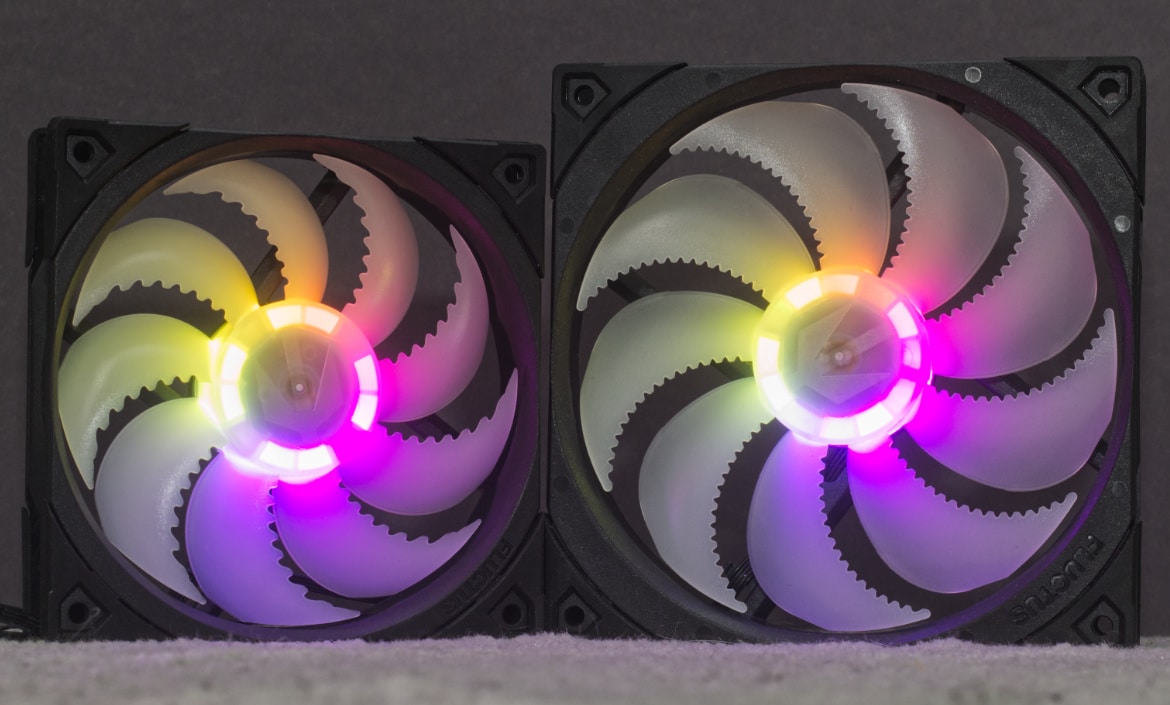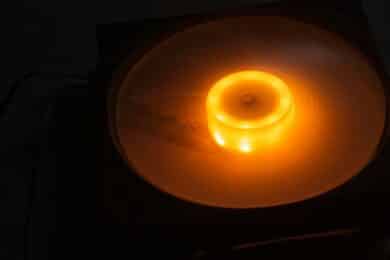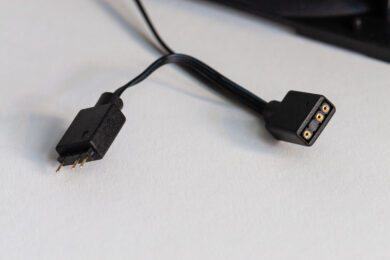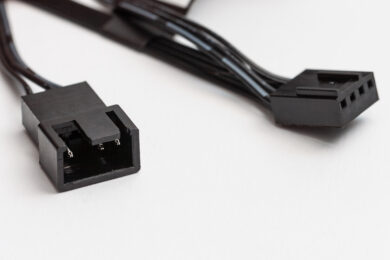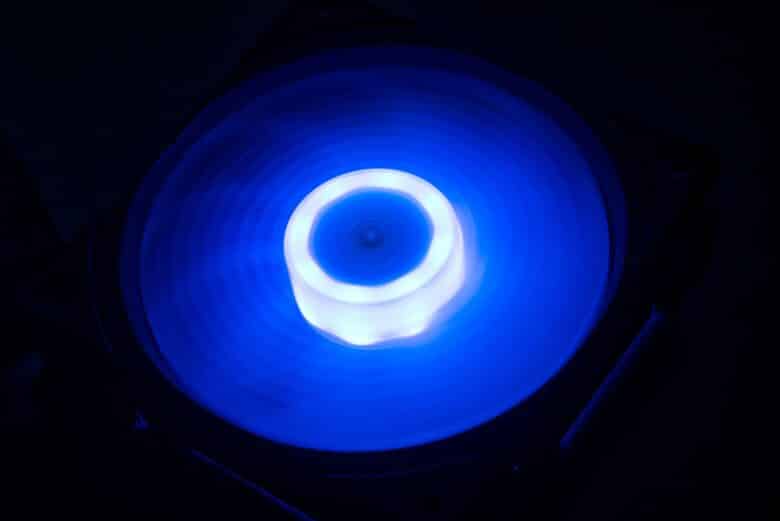ENDORFY, known as SilentiumPC until 2022, is a Polish brand that has been known for coolers and fans in particular. However, the ENDORFY Fluctus RGB fans in 120 and 140 mm are my first personal contact with this brand. It is all the more interesting to take a close look at them in this ENDORFY Fluctus ARGB fan review. Herewith I want to see what these fans can do and where their optimal range of use lies.
Specifications
140 mm
| designation | ENDORFY Fluctus 140 PWM ARGB |
| Size | 140 x 140 x 25 mm |
| Speed | 250 – 1800 RPM |
| Bearing | Fluid Dynamic Bearing |
| RGB Lighting | ARGB Standard (male + female) |
| Fan connector | 4-pin PWM (male + female) |
| Guarantee | 6 years |
| Price | € 20.48 * |
120 mm
| designation | ENDORFY Fluctus 120 PWM ARGB |
| Size | 120 x 120 x 25 mm |
| Speed | 250 – 1800 RPM |
| Bearing | Fluid Dynamic Bearing |
| RGB Lighting | ARGB Standard (male + female) |
| Fan connector | 4-pin PWM (male + female) |
| Guarantee | 6 years |
| Price | € 21.30 * |
Packaging and scope of delivery
- Sleek, “seriously playful” packaging
- Scope of delivery includes a PWM extension cable and fan screws
The packaging of the ENDORFY Fluctus RGB fans is kept bright and modern. At first glance, the box even looks almost industrially objective, until you notice the slogans and design elements in ballpoint pen look.
These playfully lighten up the design without making it look unserious.
Design
- Marked shape of the fan blades
- Black unlit frame
- Lit fan blades are visually compatible with many other RGB fans
The ENDORFY Fluctus ARGB fans feature a black frame with tapered corners. Only the fan blades are illuminated. Their shape stands out from the mass of fans, as they are serrated throughout. In the center of the fans – barely visible – the brand’s logo is pressed into the plastic.
The lighting on the ENDORFY Fluctus ARGB fans is strong, but they don’t stand out among other fans with illuminated fan blades. On the one hand, this is a shame, as they hardly offer any unique visual features. On the other hand, they can thus be optically combined well with other fans. The teeth are also a bit visible at high speeds, but you have to pay attention to that.
Workmanship
- Decent workmanship with no standout flaws
- Rubber corners match the frame perfectly in color
- Daisy-chain connection possible
The workmanship of the ENDORFY Fluctus ARGB fans is very solid. The frame looks unspectacular at first, but the material feels high-quality and the edges are cleanly finished. There are a few smoother spots on the front where the plastic was presumably molded.
The rubberized support surfaces at the corners are pinned, similar to Noctua fans. However, the color of the frame is perfectly matched, so that it is hardly noticeable at first glance that these are plugged-on parts.
The fan blades are also cleanly finished and there are no rough-looking edges. The LEDs around the fan bearing can be located visually, but do not stand out negatively.
It’s quite cool that you can connect the fans to each other in series through the connectors, which are both male and female. Thus, you can move the cable clutter to the non-visible area and only need a few headers on the motherboard or controller to use a few fans. This makes the fans usable even on cheap mainboards, which are usually not equipped with many headers.
Overall, I would classify the build quality as upper mid-range like this.
Loudness
- High efficiency at low speeds makes for low possible volumes
- High maximum speed results in high performance while still maintaining a humane volume
One thing ahead: the fans in this test all achieved a higher maximum speed than the specifications promised. The ENDORFY Fluctus 120 ARGB reached 1920-1990 RPM, depending on the application, and the 140mm version was at least close to 1900 RPM.
On the subject of noise: again, the Fluctus fans weren’t the quietest in the test, but each were in the quietest 20% range compared to RPM. Sure – when fans operate at 1900 RPM, especially large 140mm fans, they are no longer quiet. But even in this speed range, the ENDORFY Fluctus could not escalate the noise. Comparing the 120mm fans, whose maximum speed was roughly in the 1950 to 2050 RPM range, really only the non-RGB Noctua NF-A12x25 and Cooler Master Mobius 120 fans were quieter. And the ENDORFY fans were in a comparable performance range.
The ENDORFY Fluctus 140 ARGB are quite lonely in this speed range. Above that were high-speed fans, like the be quiet! Silent Wings Pro 4 or the Noctua NF-A14 industrialPPC-3000. Below that, the Arctic P14 PWM PST A-RGB and NZXT F140 RGB. This makes the comparison a bit more difficult. On the other hand, the Noctua NF-P14s redux-1500 PWM were in the similar volume range, spinning much slower and thus performing weaker. Or the Corsair iCue AF140 RGB Elite, which also spin slower but come closer in terms of performance.
In summary, the ENDORFY Fluctus ARGB fans are very efficient when it comes to volume.
Performance
- Solid performance across the board
- All-around performance beaten by specially optimized fans in certain applications
The ENDORFY Fluctus ARGB fans run like a constant red ribbon through the tests. They are actually never found in first place on the performance charts, but almost always very high up.

With many fans, you can measure out a specialty. So fans that excel on radiators but are mediocre as case fans (like the Noctua NF-A12x25). Or vice versa (like the Noiseblocker NB-eLoop X B-12-PS). Or one of the sizes performs solidly, while the other size is less than up to expectations (like the be quiet! Light Wings, whose 140mm version is good, while the 120mm version weakens).
The situation is different for the ENDORFY Fluctus ARGB fans in this test. Even though they can definitely be beaten by specialists, there are hardly any fans that sit so contantly in the upper performance range. They can be quiet while offering decent performance. But they can also turn up the volume. In addition, they show their high performance in virtually every area. No matter if on the radiator, the air cooler or as case fan. A few outliers of the measurement results can be found on radiators at most, when the speed range is chosen rather low. This affects both sizes. However, outlier sounds wilder than it is in this case. Even here, a performance is achieved that is located in the narrow field of the mid-range. Here you can also find in corresponding tests, for example, the be quiet! Silent Wings 3 140mm, the Noctua NF-P12 or the Seasonic MagFlow 1225 PWM.
Coming close again and again in the tests are the Corsair iCue AF Elite fans. These pull into similar ranges in the areas of volume and performance in almost all tests, but fall higher in price (especially in the RGB version) than the ENDORFY Fluctus.
Conclusion
The ENDORFY Fluctus 120 and 140 ARGB are consistently solid performing fans that offer a high speed range while keeping the noise under control. This results in very consistently high performance. Even more so, the Male-Female connectors allow you to simplify cabling and save headers on your motherboard or controllers. Last but not least, they achieve this high performance as ARGB fans that operate independently of proprietary systems with a standard connector.
And that’s what both the 120mm and 140mm versions of the ENDORFY Fluctus PWM ARGB achieve in this test. Overall, a thoroughly impressive result. There are specialists in every field, but the ENDORFY Fluctus 120 and 140 ARGB are the eierlegende Wollmilchsäue among fans: They can do everything – and do it pretty well. Thus, they are especially suitable if you want to use uniform fans everywhere or if you are not sure whether you would like to use them in other positions at some point.
Workmanship
Features
Cooling
Noise level
90/100
The ENDORFY Fluctus 120 PWM ARGB and Fluctus 140 PWM ARGB know how to convince as almost perfect all-rounder fans.
ENDORFY Fluctus 120 PWM ARGB price comparison
By purchasing via the links from our price comparison, you support our editorial work without incurring additional costs. We thank you for your support.

